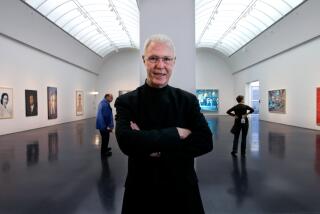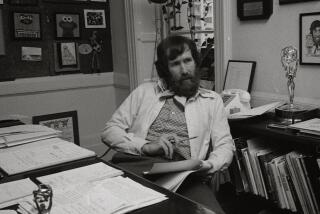Puppetry for a New Age
- Share via
Susan Simpson carries a theater in her suitcase.
Between its frayed tan sides rest the players in her imagination’s tragedies and comedies. These actors move through real time and space but can be as abstract as any cartoon.
The suitcase cast consists of puppets whose portable performances adapt to any age group or venue. But it’s not easy to convince Americans weaned on “Sesame Street” that puppets are more than kid stuff.
Simpson, a graduate student in animation at the California Institute of the Arts, hopes to change that.
“When I tell people that I do puppetry, a lot of what I get is, ‘Oh, I haven’t seen puppetry since I was a kid,’ ” said the laconic Simpson, 27. “That’s what it is in this country. We lag behind a lot of countries where it is more a part of the arts. People here just know the Muppets.”
While the art of puppetry is centuries old, Simpson believes artists of her generation may be able to carry it into the next century and create an alternative to the ubiquitous culture of music videos and Web pages.
“There’s just something so perfect about puppets, something about living in a time when you’re surrounded by images,” she said, her northern Vermont reserve thawing. “You’re taking the everyday, realistic language of movement and tweaking it in some way.”
Simpson is trying to pull some strings at CalArts, too, where she’s pushing for a puppetry program. She envisions a multidisciplinary pursuit, drawing on the tenets of animation, theater, visual art and music.
The proposed Center for Puppetry and the Arts could be on its feet by 2000, with at least two full-time faculty members and several specific courses. In the U.S., only a few small puppetry centers offer such concentrated instruction, and nothing close exists at a four-year college.
This bid can hardly be dismissed as another student stunt at the college long known for its experimental bent. CalArts President Steven Lavine and Susan Solt, dean of the theater school, have signed on enthusiastically. Cheryl Henson, who runs a New York foundation in the memory of her husband Jim Henson, creator of the Muppets, has written a letter of support and offered a small donation.
Artists backing the plan include Lee Breuer, who directed a puppet version of “Peter Pan” that ended its critically hailed run at the Geffen Playhouse in December, and Janie Geiser, a New York-based director and designer who incorporates puppetry into plays and films.
Breuer visited the campus recently for a workshop, showing about a dozen students some of the secrets behind “Peter and Wendy.” His retelling of Sir James M. Barrie’s timeless Victorian tale uses a Japanese form of puppetry called Bunraku, in which the puppeteers appear on stage but their subdued costumes and artistry at working the puppets allow them to fade into the background.
Geiser, meanwhile, is scheduled to spend more than a week at CalArts in March. That stay will include at least one public performance.
If the attention greeting the Broadway staging of “The Lion King” is any indication, the CalArts campus and American culture in general appear ripe for change. The Disney-derived musical has earned raves for director Julie Taymor’s elaborate puppet designs created for many of the characters.
Attached to and guided by the actors, multicolored constructions made from materials such as foam rubber, clay, rope and fiberglass form what Taymor has called “a cubistic event, because the audience experiences the art from several perspectives.”
Lavine adores “The Lion King,” and has long championed the cause of puppetry.
“American theater is in a rut,” he declared. “I don’t want to see another family drama. What we’re trying to do here is renew the energies of the theater. How can we make it new again?”
One way, he suggests, is to make it more accessible. In an ironic way, puppetry has fewer limitations than many contemporary stage plays. Conventions fall away when the players no longer have human form. That is the essence of make-believe--something that appeals to young and old.
“People are blurring the line between children’s and adult theater, which I think is wonderful,” Lavine said.
Lavine’s office contains evidence of both worlds. In one corner, next to an executive-looking coffee table full of literary magazines, sits a 10-foot-tall male puppet fashioned from cardboard, limbs crossed politely.
The towering figure was designed by Simpson, who spent last summer building large-scale puppets to help unionized strawberry workers catch the attention of passing motorists during a demonstration.
It isn’t the first time she has completed a project that ended up in Lavine’s office. For a roast-like tribute when he received an award in 1996, CalArts officials commissioned Simpson to create a Lavine puppet that now decorates his home.
Simpson’s interest in puppets dates back to her school years in Lindenville, Vt. Later, at Brown University, she studied fine art and spent several months studying puppetry in Indonesia. After graduation, she opted not to pursue the traditional art gallery route. She enjoyed the kinetic feel of animation and applied to CalArts, despite having little animation experience.
Once on campus, she discovered that puppetry plays a key role in animation. Most students build movable models at some point to draw from; some even make stop-motion films that are a close relative of the live puppet show.
“I found that a lot of people knew what I was talking about when I mentioned puppetry,” said Simpson. “There’s so much about animation that is similar. A lot of the manipulation techniques are the same.”
Simpson started talking to the faculty about the possibility of teaching puppetry, and found a receptive audience in Lavine.
Lavine believes CalArts’ resources make it an ideal institution to formally teach puppetry. Most European arts academies, he noted, have merged once-separate schools for theater and puppetry.
The program at CalArts would need funding of about $750,000 over three years. Unlike a full-fledged department, the puppetry program would offer classes but no degree, so there are few bureaucratic hurdles.
“At this point, the only obstacle is money,” Lavine said. “And this is an idea of such power, I’m certain we’ll find the supporters we require.”
Organizers also envision a mobile puppet theater fashioned out of a large van. Designers are already working on plans for the van’s stage area, and CalArts officials have contacted schools and youth groups in the area to see where they could park the van for a show.
“Everyone gets it,” Lavine said. “It’s the first idea I’ve had since coming to CalArts that doesn’t make people look at me funny. They all just say, ‘Yes!” ’
One of the yes-people has been Solt, dean of the theater school. She talks excitedly of the “semiotic element” puppetry provides.
The mechanical nature of puppets allows the audience to view them as symbols. “That adds to the dimension of storytelling,” she said. “It becomes another imagined realm of playing or imagining that you can’t have in film or on stage.”
Simpson, too, revels in the symbolism and possibilities for puppets. Over coffee one morning at a cafe near her home in Silver Lake, she opens her battered suitcase and sorts through her creations.
She stops at one of her favorites, a shiny, satirical pair: a TV talk-show host and guest made mostly from wire and cellophane.
“I’m not interested in making something appear totally realistic,” she said, casting a look at the characters’ mawkish, smeared features. “I was never attracted to straight theater.”
More to Read
The biggest entertainment stories
Get our big stories about Hollywood, film, television, music, arts, culture and more right in your inbox as soon as they publish.
You may occasionally receive promotional content from the Los Angeles Times.










